unit 5 An impossible bridge
- 格式:ppt
- 大小:1.09 MB
- 文档页数:12
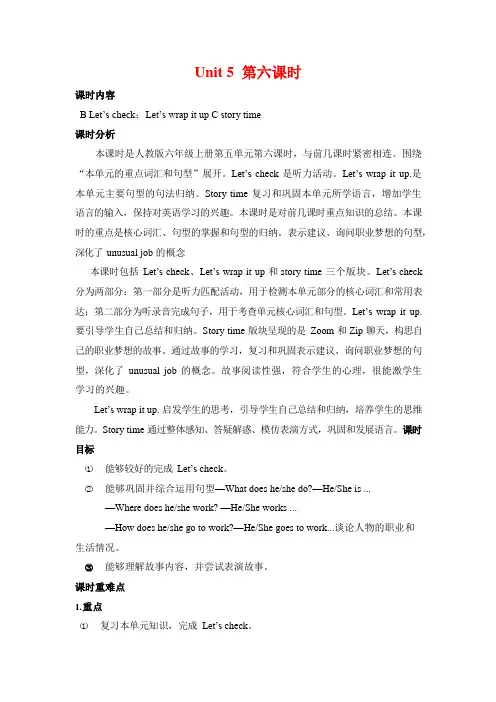
Unit 5 第六课时课时内容B Let’s check;Let’s wrap it upC story time课时分析本课时是人教版六年级上册第五单元第六课时,与前几课时紧密相连。
围绕“本单元的重点词汇和句型”展开。
Let’s check 是听力活动。
Let’s wrap it up.是本单元主要句型的句法归纳。
Story time 复习和巩固本单元所学语言,增加学生语言的输入,保持对英语学习的兴趣。
本课时是对前几课时重点知识的总结。
本课时的重点是核心词汇、句型的掌握和句型的归纳。
表示建议、询问职业梦想的句型,深化了unusual job 的概念本课时包括Let’s check、Let’s wrap it up 和story time 三个版块。
Let’s check 分为两部分:第一部分是听力匹配活动,用于检测本单元部分的核心词汇和常用表达;第二部分为听录音完成句子,用于考查单元核心词汇和句型。
Let’s wrap it up. 要引导学生自己总结和归纳。
Story time 版块呈现的是Zoom 和Zip 聊天,构思自己的职业梦想的故事。
通过故事的学习,复习和巩固表示建议、询问职业梦想的句型,深化了unusual job 的概念。
故事阅读性强,符合学生的心理,很能激学生学习的兴趣。
Let’s wrap it up. 启发学生的思考,引导学生自己总结和归纳,培养学生的思维能力。
Story time 通过整体感知、答疑解惑、模仿表演方式,巩固和发展语言。
课时目标(1)能够较好的完成Let’s check。
(2)能够巩固并综合运用句型—What does he/she do?—He/She is ...—Where does he/she work? —He/She works ...—How does he/she go to work?—He/She goes to work...谈论人物的职业和生活情况。
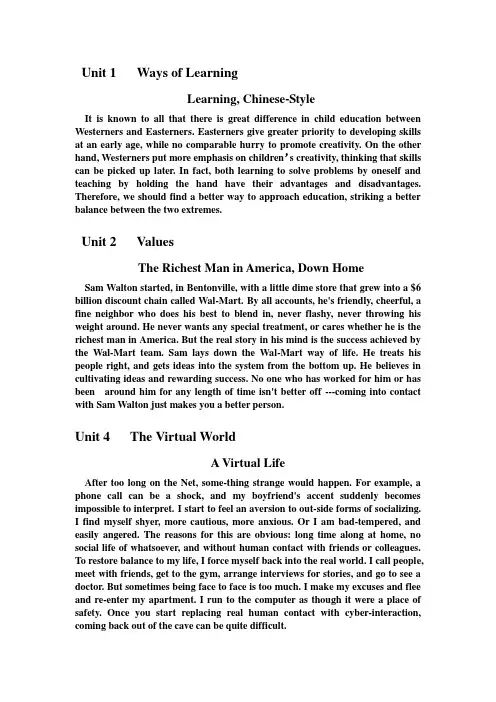
Unit 1 Ways of LearningLearning, Chinese-StyleIt is known to all that there is great difference in child education between W esterners and Easterners. Easterners give greater priority to developing skills at an early age, while no comparable hurry to promote creativity. On the other hand, W esterners put more emphasis on children’s creativity, thinking that skills can be picked up later. In fact, both learning to solve problems by oneself and teaching by holding the hand have their advantages and disadvantages. Therefore, we should find a better way to approach education, striking a better balance between the two extremes.Unit 2 ValuesThe Richest Man in America, Down HomeSam W alton started, in Bentonville, with a little dime store that grew into a $6 billion discount chain called W al-Mart.By all accounts, he's friendly, cheerful, a fine neighbor who does his best to blend in, never flashy, never throwing his weight around. He never wants any special treatment, or cares whether he is the richest man in America. But the real story in his mind is the success achieved by the W al-Mart team. Sam lays down the W al-Mart way of life. He treats his people right, and gets ideas into the system from the bottom up. He believes in cultivating ideas and rewarding success. No one who has worked for him or has been around him for any length of time isn't better off ---coming into contact with Sam W alton just makes you a better person.Unit 4 The Virtual WorldA Virtual LifeAfter too long on the Net, some-thing strange would happen. For example, a phone call can be a shock, and my boyfriend's accent suddenly becomes impossible to interpret.I start to feel an aversion to out-side forms of socializing.I find myself shyer, more cautious, more anxious. Or I am bad-tempered, and easily angered. The reasons for this are obvious: long time along at home, no social life of whatsoever, and without human contact with friends or colleagues. To restore balance to my life, I force myself back into the real world. I call people, meet with friends, get to the gym, arrange interviews for stories, and go to see a doctor. But sometimes being face to face is too much. I make my excuses and flee and re-enter my apartment. I run to the computer as though it were a place of safety. Once you start replacing real human contact with cyber-interaction, coming back out of the cave can be quite difficult.Unit 5 Overcoming ObstaclesTrue HeightAs long as Michael could remember he had always dreamed of flying. The details in his moth er’s stories made his dreams full of color and beauty. From the age of 14, Michael began a very careful training program monitored by his father. His father’s motto: If you want something, work for it. At the National Junior Olympics, Michael surpassed his personal best, won the championship and set a new world record. Michael’s success was, of course, the reward for his hard work. But people were most surprised by the fact that he is blind. Michael’s story tells us two most important factors for success --- dream or imagination, tough training or hard work.Unit 6 Women, Half the SkyI'm Going to Buy the Brooklyn BridgeDespite my friend’s warning against being taken in, yet superwomen tales continue to charm me and I consume success stories by the pound. Generally speaking, successful women are movers and shakers --- not only during office hours, but in their spare time as well. However, I am by nature completely unable to get my act together. No matter how carefully I plan my time, the plan always goes wrong.On the other hand, racing the clock every day is such an exhausting effort that when I actually have a few free moments, I tend to collapse. Perhaps becoming a superwoman is an impossible dream for me, but I still want to make a wise investment --- to buy my own version of Brooklyn Bridge.Unit 7 learning about EnglishThe Glorious Messiness of EnglishThe story of English language is typically one of massive stealing from other languages, such as French, Greek and Chinese. The French do not like borrowing foreign words because they think it corrupts their language. A systematic study revealed that many modern languages descended from a common parent language, lost to us because nothing was written down.The English language would not have been what it is if everybody had not been free to strike out new paths for himself.The same cultural soil producing the English language also nourished the great principles of freedom and rights of man in the modern world.。
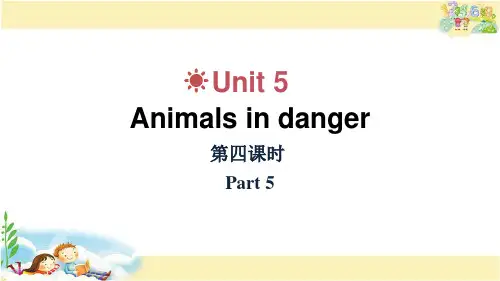
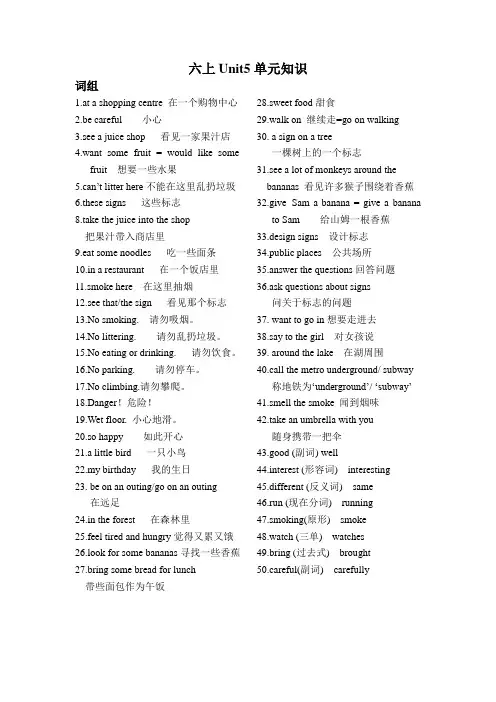
六上Unit5单元知识词组1.at a shopping centre 在一个购物中心2.be careful 小心3.see a juice shop 看见一家果汁店4.want some fruit = would like somefruit 想要一些水果5.can’t litter here不能在这里乱扔垃圾6.these signs 这些标志8.take the juice into the shop把果汁带入商店里9.eat some noodles 吃一些面条10.in a restaurant 在一个饭店里11.smoke here 在这里抽烟12.see that/the sign 看见那个标志13.No smoking. 请勿吸烟。
14.No littering. 请勿乱扔垃圾。
15.No eating or drinking. 请勿饮食。
16.No parking. 请勿停车。
17.No climbing.请勿攀爬。
18.Danger!危险!19.Wet floor. 小心地滑。
20.so happy 如此开心21.a little bird 一只小鸟22.my birthday 我的生日23. be on an outing/go on an outing在远足24.in the forest 在森林里25.feel tired and hungry觉得又累又饿26.look for some bananas寻找一些香蕉27.bring some bread for lunch带些面包作为午饭28.sweet food甜食29.walk on 继续走=go on walking30. a sign on a tree一棵树上的一个标志31.see a lot of monkeys around the bananas 看见许多猴子围绕着香蕉32.give S am a banana = give a bananato Sam 给山姆一根香蕉33.design signs 设计标志34.public places 公共场所35.answer the questions回答问题36.ask questions about signs问关于标志的问题37. want to go in想要走进去38.say to the girl 对女孩说39. around the lake 在湖周围40.call the metro underground/ subway称地铁为‘underground’/ ‘subway’41.smell the smoke 闻到烟味42.take an umbrella with you随身携带一把伞43.good (副词) well44.interest (形容词) interesting45.different (反义词) same46.run (现在分词) running47.smoking(原形) smoke48.watch (三单) watches49.bring (过去式) brought50.careful(副词) carefully句型1.What does this sign mean? It means we shouldn’t park here.这个标志是什么意思?它表示我们不应该在这停车。
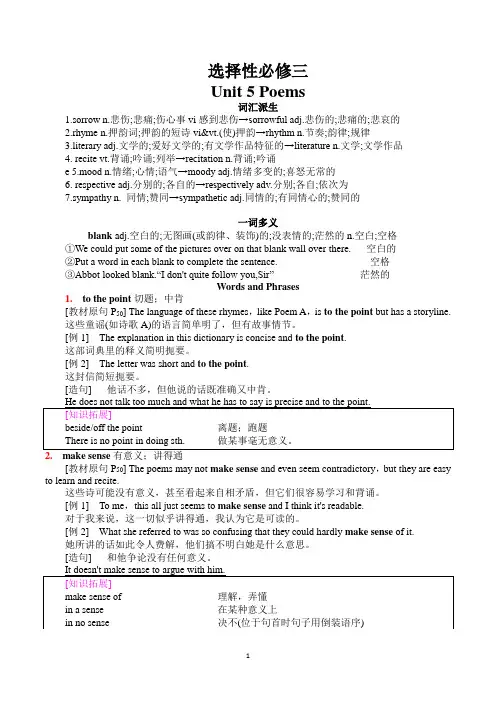
选择性必修三Unit 5 Poems词汇派生1.sorrow n.悲伤;悲痛;伤心事vi感到悲伤→sorrowful adj.悲伤的;悲痛的;悲哀的2.rhyme n.押韵词;押韵的短诗vi&vt.(使)押韵→rhythm n.节奏;韵律;规律3.literary adj.文学的;爱好文学的;有文学作品特征的→literature n.文学;文学作品4. recite vt.背诵;吟诵;列举→recitation n.背诵;吟诵e 5.mood n.情绪;心情;语气→moody adj.情绪多变的;喜怒无常的6. respective adj.分别的;各自的→respectively adv.分别;各自;依次为7.sympathy n. 同情;赞同→sympatheti c adj.同情的;有同情心的;赞同的一词多义blank adj.空白的;无图画(或韵律、装饰)的;没表情的;茫然的n.空白;空格①We could put some of the pictures over on that blank wall over there. 空白的②Put a word in each blank to complete the sentence. 空格③Abbot looked blank.“I don't quite follow you,Sir”茫然的Words and Phrases1.to the point切题;中肯[教材原句P50] The language of these rhymes,like Poem A,is to the point but has a storyline.这些童谣(如诗歌A)的语言简单明了,但有故事情节。
[例1]The explanation in this dictionary is concise and to the point.这部词典里的释义简明扼要。
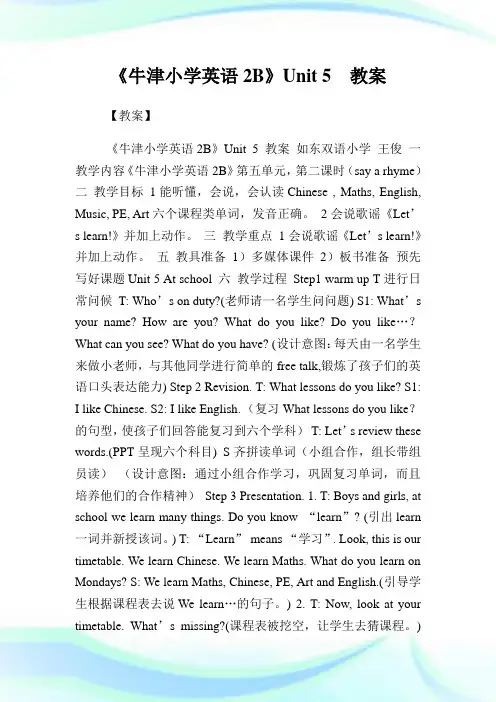
《牛津小学英语2B》Unit 5 教案【教案】《牛津小学英语2B》Unit 5 教案如东双语小学王俊一教学内容《牛津小学英语2B》第五单元,第二课时(say a rhyme)二教学目标1能听懂,会说,会认读Chinese , Maths, English, Music, PE, Art六个课程类单词,发音正确。
2会说歌谣《Let’s learn!》并加上动作。
三教学重点1会说歌谣《Let’s learn!》并加上动作。
五教具准备1)多媒体课件2)板书准备预先写好课题Unit 5 At school 六教学过程Step1 warm up T进行日常问候T: Who’s on duty?(老师请一名学生问问题) S1: What’s your name? How are you? What do you like? Do you like…?What can you see? What do you have? (设计意图:每天由一名学生来做小老师,与其他同学进行简单的free talk,锻炼了孩子们的英语口头表达能力) Step 2 Revision. T: What lessons do you like? S1: I like Chinese. S2: I like English. (复习What lessons do you like?的句型,使孩子们回答能复习到六个学科)T: Let’s review these words.(PPT呈现六个科目) S齐拼读单词(小组合作,组长带组员读)(设计意图:通过小组合作学习,巩固复习单词,而且培养他们的合作精神)Step 3 Presentation. 1. T: Boys and girls, at school we learn many things. Do you know “learn”? (引出learn 一词并新授该词。
) T: “Learn”means “学习”. Look, this is our timetable. We learn Chinese. We learn Maths. What do you learn on Mondays? S: We learn Maths, Chinese, PE, Art and English.(引导学生根据课程表去说We learn…的句子。
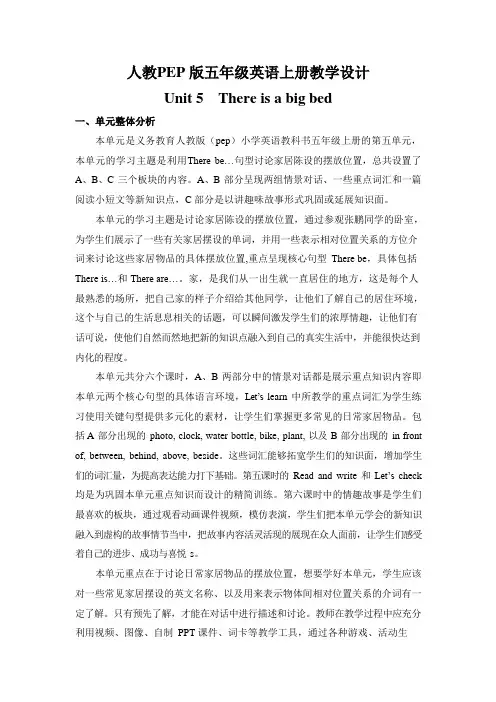
人教PEP 版五年级英语上册教学设计Unit 5 There is a big bed一、单元整体分析本单元是义务教育人教版(pep)小学英语教科书五年级上册的第五单元,本单元的学习主题是利用There be…句型讨论家居陈设的摆放位置,总共设置了A、B、C 三个板块的内容。
A、B 部分呈现两组情景对话、一些重点词汇和一篇阅读小短文等新知识点,C 部分是以讲趣味故事形式巩固或延展知识面。
本单元的学习主题是讨论家居陈设的摆放位置,通过参观张鹏同学的卧室,为学生们展示了一些有关家居摆设的单词,并用一些表示相对位置关系的方位介词来讨论这些家居物品的具体摆放位置,重点呈现核心句型There be,具体包括There is…和There are…。
家,是我们从一出生就一直居住的地方,这是每个人最熟悉的场所,把自己家的样子介绍给其他同学,让他们了解自己的居住环境,这个与自己的生活息息相关的话题,可以瞬间激发学生们的浓厚情趣,让他们有话可说,使他们自然而然地把新的知识点融入到自己的真实生活中,并能很快达到内化的程度。
本单元共分六个课时,A、B 两部分中的情景对话都是展示重点知识内容即本单元两个核心句型的具体语言环境,Let’s learn 中所教学的重点词汇为学生练习使用关键句型提供多元化的素材,让学生们掌握更多常见的日常家居物品。
包括A 部分出现的photo, clock, water bottle, bike, plant, 以及B 部分出现的in front of, between, behind, above, beside。
这些词汇能够拓宽学生们的知识面,增加学生们的词汇量,为提高表达能力打下基础。
第五课时的Read and write 和Let’s check 均是为巩固本单元重点知识而设计的精简训练。
第六课时中的情趣故事是学生们最喜欢的板块,通过观看动画课件视频,模仿表演,学生们把本单元学会的新知识融入到虚构的故事情节当中,把故事内容活灵活现的展现在众人面前,让学生们感受着自己的进步、成功与喜悦s。

![六年级上英语Unit 5-经典教学教辅文档[1]](https://uimg.taocdn.com/6f598f50fe00bed5b9f3f90f76c66137ee064f9d.webp)
Lesson5 《At the Amusement Park》第一课时一、Lead in.T: Hello, everyone!Ss: hello, Mrs. Qiu.T: It’s time for our English class. Are you ready?Ss: Yes.T: Who knows“How’s the weather like today?”Ss: warm/sunny.T: Who can tell me “Where are you going in this good weather?”Ss: I am going to the library/ zoo/KFC/park.二、New lesson.T: All kinds of good plans. Today, let’s go to the amusement park with Xiaoxiao and his friends. Please open your books and turn to page 60.We will learn Have Fun 1. First, listen to the radio with my questions.1.How tall is Jenny?2.Who is taller than jenny?3.Who is shorter than Jim?T: the first time, listen.Next, read after me.Third, read it by yourselves with my three questions.1.T: Did you finish? The first one, who knows?Ss: Jenny is 150cm tall.T: look at the picture, 厘米 cm=centimeter.1cm= one centimeter2cm= two centimeters:10cm=ten centimeters2.T: Look at the second one. Find several students to say theanswer. (simple say tall/taller)3.T: look at the last one. Find several students to say theanswer.(simple say short/shorter)4.T: please look at my picture. Tell me “How tall is Jim?”Ss: He is 160cm tall. (2.3个说),together.T: then “How tall is Jenny?”Ss: She is 150cm tall. (2.3个说),together.T: let’s look at them “Who is taller?”Ss: Jim is taller than Jenny. (Write on the blackboard)(read after the teacher、one by one、group、boys and girls、together.)T: Still this picture, “Who is shorter?”Ss: Jenny is shorter than Jim. (Write on the blackboard)(read after the teacher、one by one、group、boys and girls、together.)T: Wonderful. Now, let’s make the chant use these sentences. Listen to me carefully,taller tallerJim is taller than Jennyshorter shorterJenny is shorter than JimHow tall are you?How tall are you?T: Good job. I like you everyone. Please look at your page 60, I will give you several minutes to practice the dialogue and make the role, then act it.Are you clear? Ok, begin. T: Which group wants to act?(Call 2, 3 groups)T: The last time, boys are Xiaoxiao, girls are Jenny, and I am Jim. Boys first.T: Nice job. Who can tell me“How old are you?”Ss: I am years old. (2, 3)T: please stand there, I am 28 years old. Look at us “Whois older?”Ss: The teacher is older than the girl. (3, 4 together)T: look at us “Who is shorter?”Ss: The girl is older than the teacher. (3, 4 together)T: Just like this, please practice with your partner. (Call two groups)T: Please look at my picture. Who is older? /Who is shorter? (one by one/ together )Two rulers Which one is longer?/ Which one is shorter? T: look at my picture, whose tail is longer? / Whose tail is shorter?(one by one/ together )Two books bigger/smallerBox/ chalk heavier/lighterT: Look at me, I can run fast. Who is faster than me? (one by one/ together )T: look at my picture, who is faster? / Who is slower? (one by one/ together )三. Sum up.T: please look at the blackboard, let’s look at “What’s the same in these sentences?”(简单讲解比较级)比较级句型:A is __er than BT: Please look at my sentences. Let’s read it together. Well done. Please remember them. Now, take out of your notes, and make the sentences with these words.For example: I am taller than you are. Are you clear?(give several minutes to write and call someone to say)四、HomeworkT: I hope you remember this sentence. This is the important for this class. Now, look at today’s homework. Practice the dialogue and complete the table.Example: A: How tall are you?B: I’m cm tall.T: It’s time to say goodbye. Please remember these sentences.See you next time. Goodbye, thank you!。

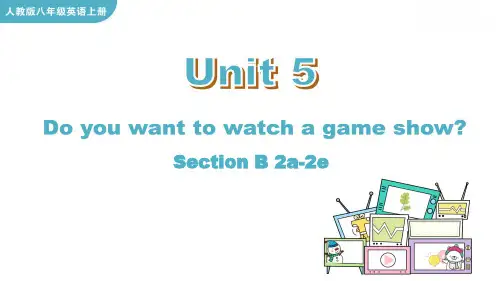
Unit 5(4)一、Teaching contents:《九年义务教育六年制小学教科书.牛津小学英语》4BUnit5 第四课时。
二、Teaching aims:1、听得懂、会说、会读第一至第四单元的日常交际用语。
2、听得懂、会说、会读、会写第一至第四单元中的句型。
3、能根据图片所提供的情景,选择相应的日常交际用语,并在气泡中填上序号。
一、Important keys:能根据图片所提供的情景,选择相应的日常交际用语。
四、Teaching difficulties:熟练掌握第一至第四单元的日常交际用语和句型。
熟练运用“询问人物”、“询问职业”、“确认人物”、“识辩事物”等语言项目。
五、Teaching aids:一组多媒体课件,学生自带家庭生活照六、Teaching procedures:Step One: Greeting and free talksT: Who’s that boy? (指着班上某一男孩提问)S1: He’s ….(指着班上某一女孩提问)T:Who’s that girl? (齐答这一问题)(安排位新转入的学生与大家问候的情景,复习:I’m new here . Welcome to our school.)Step Two: A guessing game1) Look at this picture, who is the man in a white vest? (Yao Ming)Who is the boy in a blue coat? (Ke Nan)Who is the boy in orange trousers? (Ben)Who is the girl in a skirt? (Nancy)Who is the woman in a green dress? (Ben’s mother)2)T: Now you ask, I answer.(屏幕出现刚刚的五幅图片)S1: Who’s the _____in the_____?T: He’s / She’s ______.( S2, S3, S4, S5 )3)T: Look, there are many famous stars here.Han Hong has a___, Zhang Liangying has____…(和同学们共同熟悉这些明星以及他们的特征后,引导同桌操练对话)T: Make dialogues with your desk mate.A: Who’s the _____with_____?B: He’s / She’s ______.4) 针对这些图片,小组间一问一答进行操练。
Part B 第一课时祸兮福之所倚,福兮祸之所伏。
《老子·五十八章》涵亚学校陈冠宇路漫漫其修远兮,吾将上下而求索。
屈原《离骚》江南学校李友峰知己知彼,百战不殆。
《孙子兵法·谋攻》樱落学校曾泽平一、听录音,写单词或短语。
1. 2. 3. 4.二、听录音,判断下面句子正(T)误(F )。
()1.Tots of toys in it.()3. T.()4. It's Monday.三、图中小球的位置在哪?选出相应的词语。
on above beside in front of between behind1.()2.()3.()4.()5.()6.()四、根据首字母或汉语提示补全句子。
1. Tl u________ te.4. Tl c l. Our cute dog is bee is between two ce?听力材料:一、1. grandparents 2. ower 4. in front of二、1. Towers .4. It's Monday.答:一、1. grandparents 2. ower 4. in front of二、1. F 2. T 3. F 4. T三、1. behind 2. in front of 3. beside 4. between 5. on 6. above四、1. front 2. under 3. on 4. beside the be 5. behind the door五、1. D 2. C 3. A 4. E 5. B【素材累】不要叹人生苦短,若把人一生的足迹连接起来,也是一条长长的路;若把人一生的光阴装订起来,也是一本厚厚的书。
开拓一条怎样的路,装订一本怎样的书,这是一个人生命价值与内涵的体现。
有的人的足迹云烟一样消散无痕,有的人却是一本耐读的厚书,被历史的清风轻轻翻动着,给一又一代的人以深情的启与深刻的昭示。
Part B 第二课时知人者智,自知者明。
《老子》棋辰学校陈慧兰物以类聚,人以群分。
《易经》如海学校陈泽学投我以桃,报之以李。
《诗经·大雅·抑》翰辰学校李道友组长一、听录音,写单词。
1. 2. 3. 4.二、听录音,判断下面句子正(T)误(F)。
()Wookat tean. Tiving room. In tiving room, tlow cant on tisant. ()1. Tant on tean.()5. Tlow.听力材料:一、1. beside2. between3. beants here.4. There is a tree in front of the house.答案:、1. beside 2. between 3. behind 4. above二、1. T 2. T 3. F 4. F三、1. E 2. D 3. C 4. B 5. A四、1. B 2. C 3. B 4. C 5. B五、1. T 2. F 3. T 4. T 5. T司马迁写《史记》汉朝马迁继承父业,立志著述史书。
他游历各地,阅读了大量书籍。
不料正在他着手编写《史记》时,遭到了李陵之祸的株连。
但他矢志不渝,忍辱负重,身受腐刑,幽而发愤,经过十余年的艰苦奋斗,终于写成了鸿篇巨著——《史记》宋庆龄自1913年开始追随孙中山,致力于中国革命事业,谋求中华民族独立解放。
在近70年的漫长岁月里,经过护法运动(1917年)、国民大革命(1924—1927年)、国共对立十年(1927—1937年)、抗日战争(1937—1945年)、解放战争(1945—1949年),她始终忠贞不渝地坚持孙中山的革命主张,坚定地和中国人民站在一起,为祖国的繁荣富强和人民生活的美满幸福而殚精竭虑,英勇奋斗,在中国现代历史上,谱写了光辉的篇章。
宋庆龄因此被誉为20世纪最伟大的女性之一。
从诞生的那一刻起,我们就像一支离弦的箭,嗖嗖地直向着生命的终点射去。
泸定桥英语作文The Luding Bridge, spanning the Dadu River in the Garze Tibetan Autonomous Prefecture of Sichuan, is more than just a bridge; it's a monument etched in the annals of Chinese history, a testament to courage, and a symbol of revolutionary triumph. Its iron chains sing tales of valor, echoing with the footsteps of heroes who dared to tread where many faltered. The bridge isn't merely a connection between two banks; it bridges past and present, reality and legend, weaving a narrative that continues to inspire generations. The year was 1935, and the Red Army, on its arduous Long March, faced a formidable obstacle – the Dadu River. The bridge, their only passage across the raging torrent, lay in ruins, its planks removed by the opposing Kuomintang forces. Hope hung by a thread, as thin as the remaining iron chains that swayed precariously above the tumultuous waters. Yet, the Red Army was no stranger to adversity. With unwavering resolve and a spirit that refused to be dampened, a group of 22 volunteers, led by the intrepid commander Yang Chengwu, stepped forward. Armed with little more than courage and hand grenades, these men embarked on a perilous mission. They crawled, hand over fist, on the skeletal remains of the bridge, the icy wind whipping at their faces, the river roaring a menacing symphony below. Enemy fire rained down upon them, each bullet a chilling reminder of the stakes. But they pressed on, their hearts fueled by an unwavering belief in their cause, their minds focused on the countless comrades waiting on the opposite bank. One by one, they secured the bridge, replacing the missing planks with their own bodies, forming a human shield against the enemy's onslaught. The successful crossing of the Luding Bridge marked a pivotal moment in the Long March. It was a victory snatched from the jaws of defeat, a testament to the indomitable spirit of the Red Army. It proved that courage, when intertwined with conviction, could conquer even the most insurmountable of challenges. The bridge, once a symbol of despair, transformed into a beacon of hope, its iron chains forever resonating with the spirit of sacrifice and the unwavering pursuit of a dream. Today, the Luding Bridge stands as a popular tourist destination, drawing visitors from across the globe who come to pay homage to the heroes of the Long March. As they walk across the bridge, feeling the wind against their faces and the swaying of the chains beneath theirfeet, they can almost hear the echoes of the past – the shouts of defiance, the clang of metal against metal, the triumphant cheers of victory. The bridgeserves as a potent reminder that the path to progress is often paved with struggle, and that the human spirit, when ignited by a righteous cause, can achieve the seemingly impossible. The Luding Bridge is more than just a historical landmark; it's a living testament to the human spirit's tenacity. It reminds us that even in the face of seemingly insurmountable odds, courage, conviction, and a collective will can bridge the chasm between despair and hope, leading to victories that resonate through the ages. Idiomatic Expressions: Hope hung by a thread (meaning a situation is precarious and uncertain) (to be) no stranger to (meaning to be familiar with something, often something unpleasant) hand over fist (meaning rapidly and in large amounts) a menacing symphony (figurative language to describe a threatening sound) snatched from the jaws of defeat (meaning to achieve victory despite being very close to failure) paved with struggle (meaning the path to success is often difficult) The story of the Luding Bridge is a powerful reminder that even in the darkest of times, hope can prevail. It is a story that will continue to inspire generations to come, encouraging them to face their own challenges with the same courage and determination as the heroes of the Long March.。